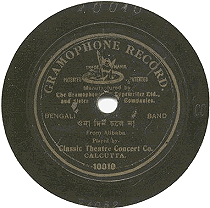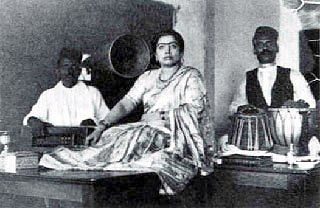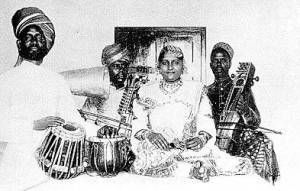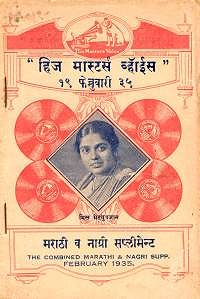Foreign
Language Labels
From
his first recordings in London on August
8, 1898 until well into the First World
War, Fred Gaisberg made over 20,000
recordings in nearly every country in
Europe and in Asia, commonly referred
to as the Far East, in some thirty languages
and dialects. Many of these were issued
with labels in appropriate language,
in order to maximize sales in that particular
country. It was customary for labels
bearing the Recording Angel trademark
to note the city where the recording
had been made, e.g., London, Paris,
Milan, Madrid, St. Petersburg, Moscow,
Warsaw, Berlin, Budapest, Bucharest,
and so forth. In some instances labels
bore inscriptions in the language of
the recorded selection, while in others
it indicated the recording location.
Recordings made in Russia frequently
did not indicate where they had been
made, but were printed largely in Russian,
using the Cyrillic alphabet. Recordings
made in Arabic, Hindustani and other
Asiatic languages, including Chinese,
often bore labels in those respective
languages.
On
May 17, 1899 Fred Gaisberg and William
Sinkler Darby embarked on the first
foreign tour, the so-called Six Cities
tour, which began in Leipzig and included
recording sessions in Budapest, Vienna,
Milan, Paris, and Madrid. The serial
or matrix numbers were assigned by continuing
the sequential series begun in London
in the previous year, beginning with
matrix 2124 in Leipzig and ending with
3494 in Madrid. By this time the catalog
system that was to be used throughout
the acoustical era had been established.
Thus, the recordings in Leipzig were
assigned catalog numbers in the 40000
series, denoting Germany, while those
in Budapest and Vienna were given numbers
in the 70000 series to indicate what
is now the Czech Republic and Slovakia
but which then included Austria and
Hungary. The Milan recordings were numbered
in the 50000 series for Italy, in Paris
in the 30000 series for France, and
in Madrid in the 60000 series for Spain
and Portugal. Thus the fifth number
from the right indicated the country
or region of origin or the language
of the selection. When the recording
engineers returned to London, the system
was continued. Details may be found
in Alan Kelly’s work, referenced in
the Bibliography.
Far
East Recordings
In
1901, J W Hawd came to Calcutta and
soon a branch office was opened. Frederick
William Gaisberg arrived in November
1902 for his first recording expedition,
together with George Dillnutt as his
assistant, and recorded about five hundred
songs. On
his first trip to the Far East from
September 29, 1902 to August 8, 1903,
he made recordings in seven countries
in no less than twenty different languages
and dialects. Between November 8, 1902
and some time in June 1903, he and George
Dillnutt made some 1,132 seven-inch
and 711 ten-inch recordings in nine
different languages, in Calcutta, Tokyo,
Shanghai, Hong Kong, Singapore, Bangkok,
and Rangoon. They returned to London
on August 8, 1903. Of the 554 matrices
sent from Calcutta back to the Hanover
plant, only about half were processed
into issued records for sale in India,
the remainder having been deemed musically
unsuitable. The recordings made on this
tour were the only ones to ever use
the E prefix. [Author’s note:
the team carried with them some 2,000
wax recording tablets, packed in wooden
crates and weighing well over 500 pounds.]
|
Location
|
10"
Records
|
7"
Records
|
Recording
Dates
|
Language
|
|
Calcutta,
India
|
E100
to E316
|
E1000
to E1336
|
8-11-02
to 6-12-02
|
(Bengali,
Hindi)
|
|
Tokyo,
Japan
|
E317
to E428
|
E1337
to E1502
|
4-2-03
to 28-2-03
|
(Japanese)
|
|
Shanghai,
China
|
E429
to E557
|
E1503
to E1702
|
18-3-03
to 27-3-03
|
(Mandarin)
|
|
Hong
Kong
|
E558
TO E618
|
E1703
to E1788
|
23-4-03
to 26-4-03
|
(Cantonese)
|
|
Singapore
|
E619
TO E688
|
E1789
to E1932
|
-5-03
to -5-03
|
(Malay,
Javanese)
|
|
Bangkok
|
E750
TO E780
|
E2000
to E2065
|
-6-03
to -6-03
|
(Siamese)
|
|
Rangoon,
Burma
|
E800
to E868
|
E2100
to E2189
|
-6o3
to -6-03
|
(Burmese)
|

Recorded
in Calcutta, November 16, 1902
Indian
Labels and Recordings
The
first ever Indian voice was recorded
by Fred Gaisberg at the Maiden Lane
studio in London in February 1899.
These were 7" Berliner records with
recording on one side only. None
of these records have been found by
the collectors but these were listed
in Gramophone Company’s ‘foreign’ lists
up to 1904. Some 44 7-inch Berliner
recordings, numbered 10000 to 10043,
were made in Hindi, Persian, Arabic,
Urdu, and Sikh. These have not been
listed in Alan Kelly’s catalogs, and
have no serial numbers. Some of these
numbers were used again for the recordings
made in Fred Gaisberg’s first Far East
tour. Thus, his recordings with matrix
numbers E1042 through E1056 were issued
as Berliners 10000 through 10014. The
latter can be distinguished from the
first series by the serial numbers with
E prefixes.
In
1900 the population of India was approximately
234 million, nearly five times that
of the Russian Empire. The inhabitants
spoke more than twenty different languages
and dialects, and had a musical culture
reaching back several thousand years.
India, like Russia and China, represented
a vast potential market for gramophone
instruments and records. This potential
market led to three major recording
tours by Gramophone Company experts
between 1902 and 1908, led by Fred Gaisberg,
William Sinkler Darby, and Will Gaisberg,
respectively.
During
1902-08, ‘The Gramophone Company’ issued
over 1000 recordings on shellac discs.
This was an outcome of the recording
expeditions led by F. W. Gaisberg. Recordings
of over 8-10 very famous artists helped
in establishing the business in India.
However, in this process some five hundred
artists made recordings for the Company.
They belong to North and South Indian
states and have recorded vocal and instrumental
music. Their names are mentioned in
the company registers and catalogues,
and some examples of discs have also
been found. However, these are almost
forgotten now. Hence it is necessary
to record their work. Here is an attempt
to note female singers of that period.
In
the beginning around 1902, many artists
of Star, Minerva, Emerald and Corinthian
theaters in Calcutta recorded songs
and dialogues from stage plays. Prominent
among them were – Miss Soshi Mukhi,
Miss Fani Bala, Miss Susheela, Miss
Acheria, Miss Binodini, Miss Kitten,
and Miss Rani. Another category of the
artists consists of ‘Bai’, ‘Jan’ and
‘Dasi’. They were either kothewali’s/tawaifs
or in the services/patronage of kings
and wealthy landlords belonging to elite
class. They belonged to Lucknow, Banaras,
Panipat, Avadh, Jalandhar, Calcutta,
Delhi, Patna, Gaya, State of Jawara.
(From The journal of the ‘Society of
Indian Record Collectors’, 2006)
On
November 14, 1902 (Alan Kelly says November
11),
the
first (!) recording of Indian classical
music was engraved in the grooves of
a gramophone record. A very rudimentary
and makeshift recording studio had been
set up in two large rooms of a hotel
in Calcutta by the Gramophone Company.
Frederick William Gaisberg and his assistants
had arrived just three weeks before
from England on their first Far East
recording expedition for the Gramophone
Company. They had appointed a
local agent for selecting and training
artists for recording on gramophone
discs. However, the agent selected
Anglo-Indian artists and completely
ignored local talent. Gaisberg
then sought the help of the local Police
Superintendent, visited several theaters,
attended mehfils at wealthy Jamindars’
palaces, and thus found at least one
promising artist to begin with.
The artist was a very famous dancing
girl, and her voice was very sweet;
although not for European ears.
She agreed to a recording session for
the handsome fee of 3,000 rupees.
Such an artist was necessary in order
to build a firm business foundation
on the Indian scene, especially when
several other German, French and American
recording companies were also planning
to capture the Asian market in general
and the Indian market in particular.
At
around 9 a.m. a young lady entered the
studio with all her paraphernalia, including
accompanists and relatives. Loaded
fully with very expensive ornaments
and jewelry, this 30 year old, fair,
medium-built lady went onto the stage
prepared  for the recordings.
for the recordings.
Sarangi (Hindi: is
a bowed string instrument of India,
Nepal and Pakistan, harmonium, and tabla
players began to tune their instruments.
(The
tabla
is
a bowed string instrument of India,
Nepal and Pakistan, harmonium, and tabla
players began to tune their instruments.
(The
tabla  is a popular Indian percussion instrument
used in the classical, popular and religious
music of the Indian subcontinent and
in Hindustani classical music. The instrument
consists of a pair of hand drums of
contrasting sizes and timbres.)
Gaisberg personally checked the equipment.
A thick wax master record was placed
on the turntable rotating at 78 rpm.
A huge recording horn was fitted on
the wall behind her and close to her
face, and she was asked to sing loudly
into the horn. At the narrow end
of the long horn a diaphragm fitted
with a needle was connected to the recording
machinery, with a needle placed on rotating
disc for cutting the grooves.
Gaisberg requested her to sing for three
minutes and announce her name at the
end of the recording. At the end
of the trial recording she announced
- "My name is Gauhar Jan". This announcement
was necessary since the wax masters
were sent to Hanover in Germany for
pressing the records and the technicians
would make proper labels and confirm
the name by listening to these announcements
at the end of the three minutes performance.
is a popular Indian percussion instrument
used in the classical, popular and religious
music of the Indian subcontinent and
in Hindustani classical music. The instrument
consists of a pair of hand drums of
contrasting sizes and timbres.)
Gaisberg personally checked the equipment.
A thick wax master record was placed
on the turntable rotating at 78 rpm.
A huge recording horn was fitted on
the wall behind her and close to her
face, and she was asked to sing loudly
into the horn. At the narrow end
of the long horn a diaphragm fitted
with a needle was connected to the recording
machinery, with a needle placed on rotating
disc for cutting the grooves.
Gaisberg requested her to sing for three
minutes and announce her name at the
end of the recording. At the end
of the trial recording she announced
- "My name is Gauhar Jan". This announcement
was necessary since the wax masters
were sent to Hanover in Germany for
pressing the records and the technicians
would make proper labels and confirm
the name by listening to these announcements
at the end of the three minutes performance.
[Author’s
note: Several references indicate clearly
that the first Indian recordings in
Calcutta were made by Miss Soshi Mukhi
on Saturday, November 8, 1902. The first
ever `native' recording in India, done
professionally by the engineers of the
Gramophone Company, England, one of
the two major companies in this field
during the acoustic era, was in 1902.
"Two little nautch (dancing) girls,
aged 14 and 16 with miserable voices,"
as one of the engineers, Fred Gaisberg,
sent on this expedition noted in his
diary, were the first Indians to have
their voices recorded. The two little
girls were Soshi Mukhi and Fani Bala,
who were associated with the Classic
Theatre. The first ever Indian song
on a gramophone disc was "Kanha jeevan
dhan... " from the play, Sri Krishna.]
(Above
is from the website http://www.mustrad.org.uk/articles/indcent.htm.
The following is from Michael Kinnear’s
website.)
 In
order to have recorded documentation for
making paper labels, the artists were
asked to announce their names in English
at the end of singing. This helped
the technicians in Germany in making the
final records ready for sale. Hence,
several records of that period have words
‘Made in Germany/Hanover’ printed on the
label and the announcement at the end.
Initial recordings were taken from ‘Nautch
Girls’ (dancing girls) and ‘Baiji’s’ or
‘Kothewalis’. Later on celebrities
like ‘Gauhar Jan of Calcutta’, ‘Jankibai
of Allahabad’, ‘Peara Saheb’ recorded
prolifically for the company. This
continued for two more recording expeditions
and about 3000 wax records were made,
pressed in Germany and brought back to
India for marketing. F W Gaisberg
writes:
In
order to have recorded documentation for
making paper labels, the artists were
asked to announce their names in English
at the end of singing. This helped
the technicians in Germany in making the
final records ready for sale. Hence,
several records of that period have words
‘Made in Germany/Hanover’ printed on the
label and the announcement at the end.
Initial recordings were taken from ‘Nautch
Girls’ (dancing girls) and ‘Baiji’s’ or
‘Kothewalis’. Later on celebrities
like ‘Gauhar Jan of Calcutta’, ‘Jankibai
of Allahabad’, ‘Peara Saheb’ recorded
prolifically for the company. This
continued for two more recording expeditions
and about 3000 wax records were made,
pressed in Germany and brought back to
India for marketing. F W Gaisberg
writes:
"All
the female singers were of course
from the caste of the public women,
and in those days it was practically
impossible to record the voice of
a respectable woman. The songs
and dances were passed by word of
mouth from mother to daughter.
They began public appearances at the
age of ten to twelve years.
The clever ones went up to the top
and sometimes travelled all over the
country in great demand at the wedding
feasts of the wealthy. As they
began to make names for themselves
many of them insisted that the word
‘amateur’ should be printed on the
record label. Fees as a rule,
were very reasonable in comparison
to those paid in Europe, but recording
expenses were heavy, since most of
the artists had to be trained over
long periods before they developed
into acceptable gramophone singers."
During
Fred’s absence, his brother Will, usually
assisted by Belford Royal, made some
461 seven-inch, 1,625 ten-inch, and
about 256 twelve-inch recordings in
various locations using Fred’s series
of allocated matrix numbers. The latter
included the twelve-inch recordings
of Francesco Tamagno made in February
1903, the first made by the Gramophone
& Typewriter Limited.
Following
Fred Gaisberg’s first trip to the Far
East in late 1902, further trips were
undertaken by William Sinkler Darby
in December 1904, Franz Hampe in 1905,
and Will Gaisberg in 1907. William Sinkler
Darby, with Max Hampe as his assistant,
arrived in India from Constantinople
in early December 1904, where he made
395 seven-inch, 821 ten-inch, and 58
twelve-inch recordings in Calcutta,
Delhi, Lahore, Bombay, Madras, and Lucknow.
The recordings below were made by Darby.
|
|
|
|
Calcutta
December 1904
|
|
|
|
|
Lucknow,
January 1905 (Darby)
|
Calcutta,
January 1905 (Darby)
|
This
was followed by series of recording
expeditions in Europe, Russia and Asia
- including India. Michael Kinnear
has given detailed history in his book
The Gramophone Company’s First Indian
Recordings [1899-1908], Popular
Prakashan, Mumbai, 1994.
Between
1902 and 1908, when the parent company
in London operated in the name of The
Gramophone and Typewriter, Limited,
all pressings of ‘Gramophone’ disc records
of Indian repertoire made by the company
were manufactured at the Deutsche Grammophon,
A.G., factory at Hanover, Germany. In
1906, the board of directors in London
considered the prospect of building
a factory in India, with a site at Jubbalpore
in Central India being the first choice,
however, with the lack of water and
problems on acquiring the land being
taken into consideration, a site near
the Sealdah railway station was chosen,
with building of the factory commencing
in early 1907.
In
July 1908 the manufacturing of disc
records began at the Sealdah factory
located at 139 Beliaghata Road, Calcutta.
The name of this site originates from
the local name given to The Gramophone
Co., Ltd factory at Sealdah, nearby
the Sealdah Railway Station, in those
days, the main passenger and freight
terminus, close to the business centre
of Calcutta. Between 1902 and 1908,
when the parent company in London operated
in the name of The Gramophone and Typewriter,
Limited, all pressings of ‘Gramophone’
disc records of Indian repertoire made
by the company were manufactured at
the Deutsche Grammophon, A.G. factory
at Hannover, Germany. In January 1908,
the name of company reverted back to
its original title of The Gramophone
Company, Limited, as did the branch
in Calcutta.
 On
18 December 1908, the ‘official’ opening
of the Sealdah factory was celebrated
with an ‘at home’ function which featured
a concert ‘in the tent' by Miss Gauhar
Jan of Calcutta, who was first recorded
by The Gramophone & Typewriter,
Ltd., on 11th November 1902, and over
the next few years became the most celebrated
artist that the company had on its roster
of artists.
On
18 December 1908, the ‘official’ opening
of the Sealdah factory was celebrated
with an ‘at home’ function which featured
a concert ‘in the tent' by Miss Gauhar
Jan of Calcutta, who was first recorded
by The Gramophone & Typewriter,
Ltd., on 11th November 1902, and over
the next few years became the most celebrated
artist that the company had on its roster
of artists.
Within a few years the Sealdah factory
was manufacturing discs and assembling
machines, not only for India, Burma
and Ceylon, but also the repertoires
of the Dutch East Indies, The Malay
States, Siam, and also Hong Kong and
China. By 1921 the Sealdah factory had
become very congested and was in need
of an overhaul, and so in 1922 the power
plant, engine-room and pressing plant
were modernized to cope with the increased
work-load.
Most
of the labor force was drawn from the
local community who referred to the
factory as "Bajakhana", and as the means
of providing their livelihood, the workers
inferred that they ate ‘sound’ for a
living as if it was a gymkhana of sound.
Incidentally, Michael Kinnear’s web
page address on internet contains this
word ‘Bajakhana’ as - www.bajakhana.com.au
and it gives a detailed history of sound
recording in India in last one hundred
years.
Considering
the enormous market in India, several
rival gramophone companies from Germany,
France and England entered the market
[like the present multinational companies].
Until 1916, about 75 different record
labels/brands were seen in Indian market,
the important ones being - Nicole, Universal,
Neophone, Elephone, H Bose, Beka, Kamla,
Binapani, Royal, Ram-a-Phone (Ramagraph),
James Opera, Singer, Sun, Odeon, and
Pathe. With time, all these companies
either disappeared or were merged with
Gramophone Company. The name His
Master’s Voice (HMV) and the label first
appeared in 1916 and soon established
their monopoly in the market.
In
the ‘acoustic era’ up to 1926, the Sealdah
factory was the busiest in Asia, and
added a cabinet making house in 1926,
on the open area in front of the tank,
thus obscuring the original ‘majestic’
profile of the record factory and offices,
which included recording rooms (on the
first floor), from which emanated the
many great recordings that kept the
company profitable.
In 1928, the Sealdah factory was closed
and building work commenced at the new
factory located at 33 Jessore Road,
Dum Dum. The main building at the Dum
Dum site had at one time been the infirmary
of the Robert Clive Hospital, and was
converted to the main offices of the
company. The Dum Dum factory was equipped
with the latest disc record pressing
machinery and a separate facility for
the manufacture of wooden cabinets for
gramophones, and commenced operations
in May 1929.
A
new record pressing plant and other
facilities were built on the site, including
a separate building for recordings,
which became known as the ‘Dum Dum Studios’.
Although The Gramophone Co., Ltd., set
up recording studios in Bombay, Delhi,
Madras and other places, all pressing
of the discs produced by the company,
both for it’s own labels and several
‘private recording companies’ was done
at the ‘HMV works’, Dum Dum.
The
first Indian records were pressed at
the Sealdah plant on June 29, 1908,
from matrices that had been transferred
from the Hanover plant (see above under
Far East Recordings.). The establishment
of the plant in Hayes, Middlesex, England,
allowed all recordings made in London
to be processed there. From 1908 until
the end of the acoustical recording
era in 1925, all other recording locations
sent their finished tablets to the Hanover
plant. During the First World War (1914-1918),
the gramophone record industry depended
largely on India for the supply of shellac.
Due to high demand from gramophone record
companies, India faced extensive export
orders and was the single largest supplier
for about 75 years. Availability of
plenty of lac/shellac was one of the
reasons for setting up a record pressing
plant at Sealdah, Calcutta in 1908.
As the complete factory was built there
was no need to send the wax masters
to Germany and as a result announcements
at the end of the song also disappeared.
Japanese
Recordings
Fred
Gaisberg arrived in Yokohama from India
in the first week of January 1903, with
his assistant George Dillnutt and his
business affairs manager Tom Addiss
to make the recordings for the London
Gramophone Company. It took two weeks
for the equipment to pass through customs
and arrive at the Metropole Hotel in
Tokyo where Gaisberg set about recording
a number of musicians and vocal artists
with the assistance of Henry Black,
whom Gaisberg described as a ‘godsend’.
In Tokyo, Gaisberg’s team worked throughout
the month of February 1903 to complete
their assignment, Gaisberg making use
of Black’s contacts in the entertainment
industry to bring together a wide range
of talent after ‘two weeks visiting
theatres and teahouses and holding auditions’.
The
Metropole was central and near enough
to entertainment quarters frequented
by many of the blind musicians, geisha,
and rakugoka whom Black recruited for
Gaisberg. The records they cut included
a geisha band of ‘little women with
big European band instruments’ which
Gaisberg described as ‘the funniest
thing imaginable,’ the Imperial Household
Band, whose music was ‘weird and fascinating
indeed,’ and narrations by Black. Gaisberg’s
dairy entry for his first day of recording
in Tokyo on February 4, 1903, indicates
he did not have much initial empathy
for Japanese music.
"We
made some 54 records. Japanese music
is simply too horrible, but funny
to relate, Europeans who have been
long in the country profess to really
enjoy it, and say that there is more
in the music and acting than a casual
observer would believe."
Gaisberg
was frequently amused to find that some
of the actors whom he auditioned to
perform scenes from the kabuki would
at first insist on donning their makeup
and bringing their costumes, unused
to the idea that it was only their voices
he wanted for posterity. Gaisberg devoted
considerable space in his memoirs to
a detailed description of a visit to
the kabuki, but very little to rakugo,
noting merely that Black, whom he described
as ‘almost a professional story teller,’
performed while seated at a table delivering
narrations which lasted ‘from thirty
to sixty minutes, an amusement of which
the Japanese were extremely fond. The
scholar Shimizu Yasuyuki has claimed
that, as the first recordings made in
Japan, Black made a valuable contribution
to the linguistic study of the Japanese
language as it was spoken at the time.
Shimizu has praised Black’s spoken Japanese
as fluent and as exemplifying the standard
Tokyo dialect of the day. Thanks largely
to Black’s contacts, Gaisberg recorded
‘some six hundred titles covering every
variety of the national music.